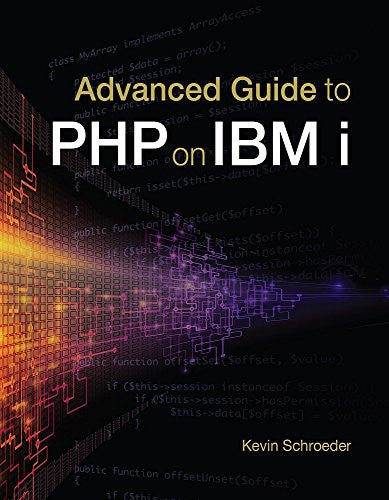It's a new way of looking at an old problem.
Editor's note: This article is an excerpt from the new book Advanced Guide to PHP on IBM i.
Have you ever run into a situation where you built something or made a change somewhere only to have it break something else? If your answer is no, wait until you graduate and get a job. It is bound to happen, and sometimes it will happen with catastrophic effects.
Part of the problem is that we do not often test our applications very well. Yes, we press refresh and maybe use a debugger, but do we have a system for testing?
But beyond using a testing system, we must go a little deeper. To best use our testing system, we have to build a testable application. A testable application is generally more complicated than the typical PHP application. However, a testable application pays for itself exponentially because it lets us repeatedly test all parts of our application to verify that they are working properly from start to finish.
Test-driven development is the practice of building out an application based on tests, rather than building it in a fluid manner. The way we naturally build applications is that we have a problem, we figure out how to solve it, we build the application, and then we test it. Test-driven development flips that process around. Instead of initially building out the application, we build the tests first and then write our code to pass the tests. It sounds a little counterintuitive, because all through our schooling years, the last thing we did before going to the graduation party was be tested. However, building our tests at the outset provides a lot of benefits.
First, it forces us to think of how we intend to use the functionality that we are creating. Second, if we are building our tests before building out the application, we are more likely to consider the required range of inputs, making us more likely to test edge conditions. This testing will lead to more stable software. Third, it makes us more productive. Unit testing has been shown both in studies and in real life to make developers more productive overall, and it is one of the few practices that have virtually no downside.
Some might claim that because you must now write both test and actual program code, you are becoming less productive. Although this might seem true at first glance, in practice it is often not the case. When writing unit tests, you are testing individual pieces of functionality. With traditional debugging, you are trying to coax the browser into performing a certain action, whether or not it wants to. And though you might be writing more code, you are writing code that is intended to verify that the function is doing what it is supposed to be doing.
Unit testing can be a complex subject to cover, but even a basic understanding of it can pay for itself. I will explain only the basics of performing unit testing here. For a more in-depth treatment of the subjects, complete books are available that provide a deeper guide into how to do unit testing.
PHPUnit
By far, the most popular PHP unit testing software is PHPUnit. It is maintained by Sebastian Bergman, and you can it download at
www.phpunit.de. PHPUnit is also included in your copy of Zend Studio.
Generally, tests are created in a separate directory from the application to prevent them from being deployed along with the application. You can, of course, put the test files alongside your class structure and remove any unwanted tests as part of your deployment process. But it is usually easier to disallow a single directory than to hope that your pattern-matching packaging process excludes all your test files.
Your tests’ structure should generally follow the structure of the items you are testing. So say you have a class called My\Class. The files related to it should be as follows:
/lib
/My
/Address.php
/tests
/My
/AddressTest.php
One practice you can use in some scenarios is to build out your class structure first and stub out the methods that you will be using. Consider this class:
namespace My;
class Address
{
public function setState($state)
{
}
public function getState()
{
}
}
This example defines the method that the class will use but does not add any functionality to it. So you can open the PHPUnit test case window in Zend Studio and have Studio create the test class for you (Figure 7.1).
Figure 7.1: Creating a test class in the PHPUnit test case window
Truth be told, Zend Studio creates a relatively ugly file. So let’s clean that file up a little:
use My\Address;
class AddressTest extends PHPUnit_Framework_TestCase {
/**
*
* @var Address
*/
private $Address;
protected function setUp() {
parent::setUp ();
$this->Address = new Address(/* parameters */);
}
public function testSetState() {
// TODO Auto-generated AddressTest->testSetState()
$this->markTestIncomplete ( "setState test not implemented" );
$this->Address->setState(/* parameters */);
}
}
What is missing in this code? It is require_once calls to the individual class you are testing along with the unit testing code. When I create a new unit test, I remove the require_once calls. I also delete a lot of boilerplate comments and other things. But to load the classes, you must first install an autoloader.
To set this up, you define a bootstrap file. Often, the bootstrap will be a PHP file in the root of the test directory. The PHP file will be called before the test run to set up the environment. One thing you do in that file is bootstrap the tests with an autoloader:
set_include_path(
get_include_path()
. PATH_SEPARATOR . realpath( __DIR__ . '/../lib')
. PATH_SEPARATOR . realpath( __DIR__)
);
spl_autoload_register(function($class) {
if (strpos($class, '\\') !== false) {
$class = str_replace('\\', '/', $class);
} else if (strpos($class, '_') !== false) {
$class = str_replace('_', '/', $class);
}
$filename = $class . '.php';
include $filename;
});
This bootstrap file can contain any functionality required to prepare the system for a test. Here, you needed only an autoloader and to set the include path. But in some cases, you might have to set a database connection or change a web service URL to a debug service.
You still have a problem, though. PHPUnit does not know where the bootstrap is. Luckily, you can configure PHPUnit with this information (and much more). PHPUnit will look for a file called phpunit.xml, which can contain various configuration options to modify how it works. Following is an example phpunit.xml file from the PHPUnit manual:
<phpunit backupGlobals="true"
backupStaticAttributes="false"
<!--bootstrap="/path/to/bootstrap.php"-->
cacheTokens="false"
colors="false"
convertErrorsToExceptions="true"
convertNoticesToExceptions="true"
convertWarningsToExceptions="true"
forceCoversAnnotation="false"
mapTestClassNameToCoveredClassName="false"
printerClass="PHPUnit_TextUI_ResultPrinter"
<!--printerFile="/path/to/ResultPrinter.php"-->
processIsolation="false"
stopOnError="false"
stopOnFailure="false"
stopOnIncomplete="false"
stopOnSkipped="false"
testSuiteLoaderClass="PHPUnit_Runner_StandardTestSuiteLoader"
<!--testSuiteLoaderFile="/path/to/StandardTestSuiteLoader.php"-->
strict="false"
verbose="false">
<!-- ... -->
</phpunit>
For your purposes, you need only one attribute set:
<phpunit
bootstrap="bootstrap.php">
</phpunit>
With that, you are ready to go.
Editor's note: To learn more about using PHPUnit in Zend Studio for test-driven development, see Chapter 7 of Advanced Guide to PHP on IBM i.
























 More than ever, there is a demand for IT to deliver innovation. Your IBM i has been an essential part of your business operations for years. However, your organization may struggle to maintain the current system and implement new projects. The thousands of customers we've worked with and surveyed state that expectations regarding the digital footprint and vision of the company are not aligned with the current IT environment.
More than ever, there is a demand for IT to deliver innovation. Your IBM i has been an essential part of your business operations for years. However, your organization may struggle to maintain the current system and implement new projects. The thousands of customers we've worked with and surveyed state that expectations regarding the digital footprint and vision of the company are not aligned with the current IT environment. TRY the one package that solves all your document design and printing challenges on all your platforms. Produce bar code labels, electronic forms, ad hoc reports, and RFID tags – without programming! MarkMagic is the only document design and print solution that combines report writing, WYSIWYG label and forms design, and conditional printing in one integrated product. Make sure your data survives when catastrophe hits. Request your trial now! Request Now.
TRY the one package that solves all your document design and printing challenges on all your platforms. Produce bar code labels, electronic forms, ad hoc reports, and RFID tags – without programming! MarkMagic is the only document design and print solution that combines report writing, WYSIWYG label and forms design, and conditional printing in one integrated product. Make sure your data survives when catastrophe hits. Request your trial now! Request Now. Forms of ransomware has been around for over 30 years, and with more and more organizations suffering attacks each year, it continues to endure. What has made ransomware such a durable threat and what is the best way to combat it? In order to prevent ransomware, organizations must first understand how it works.
Forms of ransomware has been around for over 30 years, and with more and more organizations suffering attacks each year, it continues to endure. What has made ransomware such a durable threat and what is the best way to combat it? In order to prevent ransomware, organizations must first understand how it works. Disaster protection is vital to every business. Yet, it often consists of patched together procedures that are prone to error. From automatic backups to data encryption to media management, Robot automates the routine (yet often complex) tasks of iSeries backup and recovery, saving you time and money and making the process safer and more reliable. Automate your backups with the Robot Backup and Recovery Solution. Key features include:
Disaster protection is vital to every business. Yet, it often consists of patched together procedures that are prone to error. From automatic backups to data encryption to media management, Robot automates the routine (yet often complex) tasks of iSeries backup and recovery, saving you time and money and making the process safer and more reliable. Automate your backups with the Robot Backup and Recovery Solution. Key features include: Business users want new applications now. Market and regulatory pressures require faster application updates and delivery into production. Your IBM i developers may be approaching retirement, and you see no sure way to fill their positions with experienced developers. In addition, you may be caught between maintaining your existing applications and the uncertainty of moving to something new.
Business users want new applications now. Market and regulatory pressures require faster application updates and delivery into production. Your IBM i developers may be approaching retirement, and you see no sure way to fill their positions with experienced developers. In addition, you may be caught between maintaining your existing applications and the uncertainty of moving to something new. IT managers hoping to find new IBM i talent are discovering that the pool of experienced RPG programmers and operators or administrators with intimate knowledge of the operating system and the applications that run on it is small. This begs the question: How will you manage the platform that supports such a big part of your business? This guide offers strategies and software suggestions to help you plan IT staffing and resources and smooth the transition after your AS/400 talent retires. Read on to learn:
IT managers hoping to find new IBM i talent are discovering that the pool of experienced RPG programmers and operators or administrators with intimate knowledge of the operating system and the applications that run on it is small. This begs the question: How will you manage the platform that supports such a big part of your business? This guide offers strategies and software suggestions to help you plan IT staffing and resources and smooth the transition after your AS/400 talent retires. Read on to learn:
LATEST COMMENTS
MC Press Online